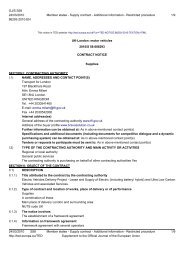Life cycle costing (LCC) as a contribution to sustainable construction ...
Life cycle costing (LCC) as a contribution to sustainable construction ...
Life cycle costing (LCC) as a contribution to sustainable construction ...
You also want an ePaper? Increase the reach of your titles
YUMPU automatically turns print PDFs into web optimized ePapers that Google loves.
Towards a common European methodology for <strong>Life</strong> Cycle Costing (<strong>LCC</strong>) – Guidance Document<br />
23<br />
5.3 Example 2: Detailed analysis of an entire <strong>as</strong>set<br />
5.3.1 Overview<br />
The “cl<strong>as</strong>sic” use of <strong>LCC</strong> is in the detailed <strong>as</strong>sessment of the life <strong>cycle</strong> costs of an entire<br />
constructed <strong>as</strong>set <strong>as</strong> part of a more detailed design/investment decision-making or budgeting<br />
process. Such instances typically arise when the project team is in place and the design is<br />
either under detailed development or completed. This example can also suit circumstances<br />
in which major design decisions need <strong>to</strong> be reviewed. It is also applicable <strong>to</strong> the operational<br />
ph<strong>as</strong>e of an <strong>as</strong>set, where it can be used both <strong>as</strong> a budgeting <strong>to</strong>ol and <strong>as</strong> a means of evaluating<br />
future remodelling/refurbishment options. The level of detail in the analysis is of high<br />
granularity. The period of analysis depends on the duration of the user’s interest in the <strong>as</strong>set<br />
but is typically 25 years or more.<br />
It should be noted that the detailed <strong>LCC</strong> analysis discussed in this section is often undertaken<br />
in parallel with the detailed system/component level analysis discussed in Section 5.4 below,<br />
<strong>as</strong> part of an integrated <strong>LCC</strong> process on a project. A typical sequence of events is <strong>as</strong> follows:<br />
a) Indicative <strong>LCC</strong> models are prepared for the <strong>as</strong>set at the early design stages (see<br />
Section 5.2 above)<br />
b) Detailed <strong>LCC</strong> models for the entire <strong>as</strong>set are prepared once detailed designs and cost<br />
plans become available<br />
c) As part of the project value management/value engineering process, key<br />
systems/components are selected, alternative options identified and <strong>LCC</strong> analysis<br />
carried out <strong>as</strong> discussed in Section 5.4<br />
d) Options selected using the system/component level <strong>LCC</strong> option analysis are integrated<br />
in<strong>to</strong> the design and in<strong>to</strong> further iterations of the detailed <strong>LCC</strong> analysis for the entire<br />
<strong>as</strong>set.<br />
In common with the overall design process, the above process is often iterative in nature.<br />
5.3.2 Objectives of the analysis (Step 1)<br />
The primary objective of undertaking an <strong>LCC</strong> analysis in this instance is <strong>to</strong> provide a<br />
detailed, robust analysis of the life <strong>cycle</strong> costs of an entire <strong>as</strong>set, b<strong>as</strong>ed on detailed<br />
design/<strong>construction</strong> information. The analysis is typically undertaken at the detailed design<br />
stages of a project or during the occupancy stage, either <strong>to</strong> inform decisions on alternative<br />
options, or <strong>as</strong> a <strong>to</strong>ol for budgeting future costs.<br />
Typical objectives for the detailed <strong>LCC</strong> analysis of an <strong>as</strong>set might include:<br />
To budget the proposed <strong>as</strong>set, i.e. <strong>to</strong> identify the economic implications of<br />
owning/operating the <strong>as</strong>set over its entire life <strong>cycle</strong> or a more limited period of time such<br />
<strong>as</strong> a period of economic interest or business planning <strong>cycle</strong><br />
To <strong>as</strong>sess alternative design options for the <strong>as</strong>set in detail, e.g. extent of refurbishment or<br />
new building works, or alternative design solutions<br />
To negotiate contract details with the client (e.g. in relation <strong>to</strong> PPP or build-operatemaintain<br />
contracts)<br />
To establish the general impact on sustainability and environment for various options<br />
Davis Langdon Management Consulting May 2007







